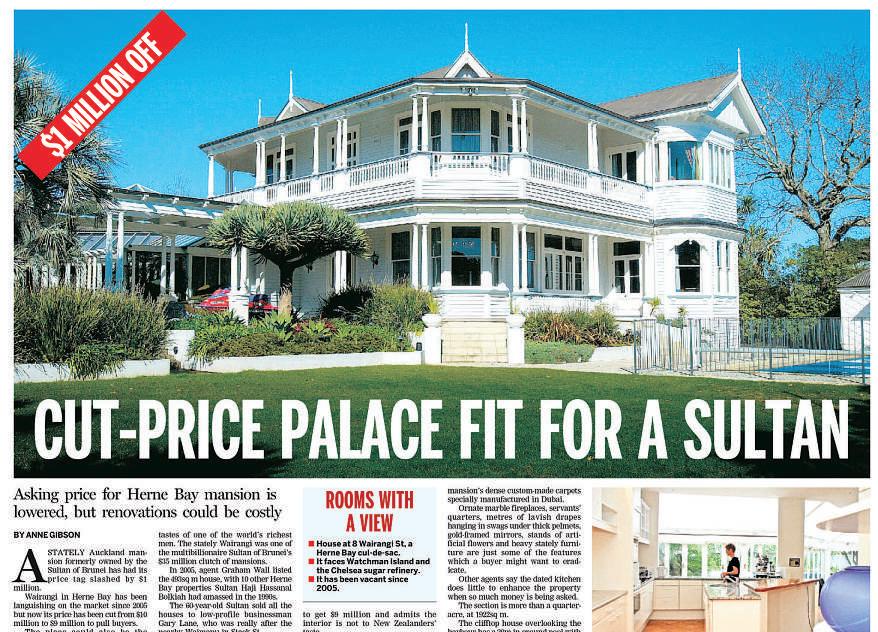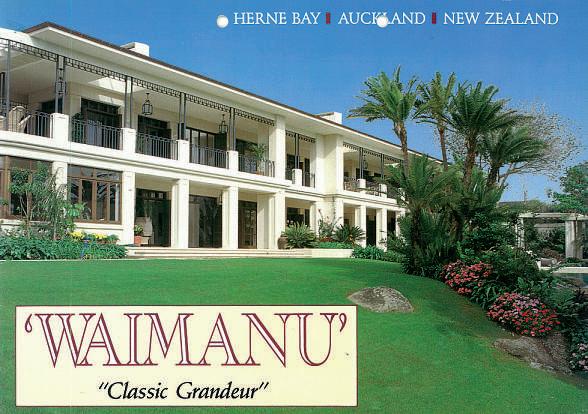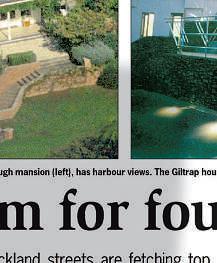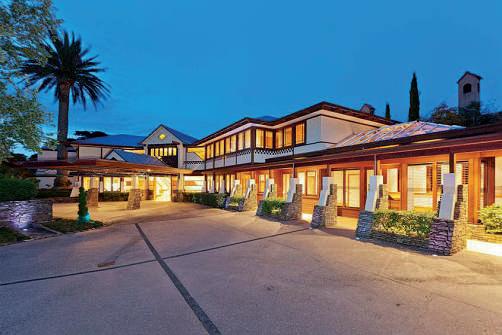
10 minute read
Rod Stewart’s in the house
Rod Stewart is in the house
CATHERINE SMITH looks at the houses that broke price records in New Zealand.
Advertisement
What do Rod Stewart, Colin Giltrap, the Sultan of Brunei and Mark Hotchin all have in common? They are all connected, in some way, to New Zealand’s biggest real estate sales.
With the number of Kiwi homes selling for $10 million or more doubling since 2019, and the number of $5m-plus sales tripling over the same time period, OneRoof decided to look back at the houses that broke price barriers and made headlines.
We talked to the agents that brokered the landmark deals and found out what made these homes special and what it took to sell them.
Most of the homes covered have a colourful history and links to some extremely wealthy and famous individuals. One even has a connection to the muddy football pitches of Glasgow.
What stands out from the research is that houses selling for crazy money are not a recent phenomenon and that some of these price records have held firm for a very long time. In fact, New Zealand’s biggest real estate sale was brokered nine years ago, and nothing has go en close since.
The first house to sell for $5m

New Zealand’s first $5m sale was way back in May 1988 when well-known Kiwi car dealer Colin Giltrap bought a Frank Lloyd Wrightstyle waterfront house on Wairangi Street, in Auckland’s Herne Bay.
Giltrap, who made headlines recently with his $10.2m sale of a luxury penthouse apartment in Tauranga, bought the Herne Bay home just before Auckland property prices had felt the full impact of the 1987 crash.
The 780sqm property, known as Monterey, was lavished with masterful detail when it was built in 1985. Architect Pete Bossley designed light fi ings, door handles, the stonework and sculptural timber framing screen in the entry way. Schist stone was used on the entry, fireplaces and walls surrounding the long narrow house. The built-in furniture was customised for the property, which also included an infinity pool, conservatory with pool, a billiard room, gym with spa and sauna, intercom system and a staff apartment above the four-car garage.
Giltrap sold the home for $7.2m in 2003, when the property market was still recovering from the 2000 crash. It was then bought for $10.75m in 2013 by National party donors and former shareholders of Kim Dotcom’s Mega, Hong Kongbased Zhao Wu Shen and Susan Chou, who sold it in 2015 for $9.25m.
The first house to break $5m
The sale that really rocked the record books was seven years later when David Murray, owner of the Glasgow Rangers FC in Scotland, sold the sprawling five-bedroom resort-style home of Waimanu, on Argyle Street in Herne Bay, for $6.75m in March 1995 in a private deal to agents snapping up properties along the street for the Sultan of Brunei, who was in town for the Commonwealth heads of government meeting in Auckland.
The sale was brokered by Bayleys agent David Rainbow, who also secured the earlier $5m deal for Wairangi Street. It was the second time Rainbow had sold the property, which was built by developer Graham Soljan in 1987. In 1989 he had brought the property to auction twice, but both times the deals fell through. He finally found a buyer in 1990, when Murray, who was on the lookout for a New Zealand base after acquiring retailer Bond & Bond, signed on the do ed line for $3.18m.
Murray, one of Scotland’s richest men, was well connected and counted many celebrities as friends, including rock star and fellow soccer fan Rod Stewart, whom he let stay at Waimanu when he was in town in 1992 (Stewart at the time was married to Kiwi model Rachel Hunter).
Rainbow remembers Waimanu well. He commissioned a glossy sales brochure to promote it; the brochure, which included a photo of a young woman in swimwear relaxing on a lilo in the pool, highlighted the property’s luxury features: a billiards room, a
music and entertaining area, a sunken pool with bridge, a commercial-sized gymnasium with squash courts, and a “state-of-the-art” electronics suite (in the late 1980s that meant a computer terminal, fax line and a 30-extension phone system, with a satellite television and 84 speakers indoors and out).
Rainbow’s brochure also carried a fax number and, rare for the time, a mobile phone number.
“The old ‘brick’, I think it was an Audivox. It was a suitcase that clicked into my car in the boot. When people called from the landline, they were charged like a toll call,” Rainbow says.
Rainbow also had a computer database to help him keep track of clients. Then, like now, selling top-end properties started with discreet phone calls to people he thought might be interested in buying, and he knew everything about them.
Rainbow can still reel off the names of the rich and famous who were buying real estate in New Zealand during the period. They were a mixture of new money merchant bankers or developers in their 30s and 40s, or older clients from solid manufacturing families.
“To some extent we were ahead of America or Australia in our marketing. Without LIMs, or AML, it was a shake of the hand and ‘let’s get on with it’,” he says, adding that although a lot of deals were done in Auckland’s then top restaurants, including Antoine’s and Clichy, that wasn’t his scene.
Rainbow, right, celebrates making a deal with
Scottish rich-lister David Murray, centre, in the 90s.
PHOTO / SUPPLIED BY DAVID RAINBOW
Graham Wall with his sons Andrew, left and ollie outside the
$38.5m "Hotchin" mansion. PHOTO / FIONA GOODALL
“TO SOME EX TENT WE WERE AHEAD OF AMERICA OR The first to break $10m AUSTRALIA IN OUR Rainbow is also connected to another record, the sale of a MARKETING. IT WAS 2345sqm house on a 5000sqm plot on Kohimarama Road, in St A SHAKE OF THE Heliers, Auckland, for $10.5m in July HAND AND ‘LET’S 2002. The buyer was Chinese and the deal GET ON WITH IT’.” was brokered through Chinese agents. The sale didn’t make headlines or news – DAVID RAINBOW, reports as it was “completely radar”, says Rainbow. under the BAYLEYS And while he had nothing to do with the $10.5m sale, he had worked closely with the vendor, rich-lister Paul Huljich, and helped him grow the size of the property. Huljich had bought the original 2520sqm plot in 1988, which came with the prep already done for a champion-sized tennis court and concepts for a mansion. Rainbow helped Huljich acquire neighbouring plots to the holding before the mansion was built in 1993. Rainbow still has the typed and spiral-bound booklets, complete with carefully glued colour photos, of the three-storeyed six-bedroom Mediterranean-style mansion. The description of features alone runs for 18 pages. The property, known as Wentworth House, included multiple living rooms, a billiard room, cinema, 100-bo le wine room, gym, steam room, spa, both indoor and outdoor pools, squash court, tennis court, croquet lawn and pavilion. Luxury touches included piped music, a walk-in catering chiller and self-contained staff quarters. For many of Rainbow’s buyers, St Heliers was too far out. “They wanted to buy in Remuera or Herne Bay,” he says. “It was a bit like Riddell Road, Glendowie. But once Graham Hart started building there, they were like bees to a honey pot.”
New Zealand’s most expensive
It took another three years for a property to break the above record. A Taupo estate claimed the title of New Zealand’s most expensive home when it sold for $13.225m in June 2005, but it didn’t hold the record very long, with a house on Waiheke Island selling for $13.85m five months later. Over the next seven and a half years, another 17 homes sold for $10m or more, then in June 2013 a mansion built by financier and director














Headlines from the past 30 years highlight our obsession with high-end real estate while stills from sales brochures show how luxury homes were marketed in the 1990s. Rod Stewart in 1991 with his then partner Rachel Hunter. The singer got to use “Waimanu”
mansion, in Herne Bay, when he was in town. PHOTOS / GETTY IMAGES, SUPPLIED BY DAVID RAINBOW













of failed Hanover Group Mark Hotchin blew away the competition and set a record that is yet to be beaten.
Hotchin’s grand home in Auckland’s Orakei had been making headlines long before it sold, with the lengthy construction process a source of fascination for Aucklanders. But Graham Wall and his sons Ollie and Andrew managed to get the biggest headline of all when they sold the house to a Chinese-born business tycoon for $38.5m.
Wall says the property was never on the open market but “circumstances dictated it be sold”.
The house was three-to-six months away from completion when the company began selling, Wall says. At that point the Lawrence Sumich-designed mansion, on three pieces of land for which Hotchin had paid $12m, had been under construction since 2009, with various pauses for planning issues to be resolved.
Reports began circulating as early as 2010 that the property was up for sale at a price then rumoured to be $30m. Wall, who made his name with the sale of the Sultan of Brunei’s Auckland properties, says Hotchin asked his company to submit a plan for selling the property.
“We said we wouldn’t run a single ad, that we knew the buyers. We only showed two people the home and they both wanted it. Then it was a ma er of price,” Wall says.
The buyer was Deyi “Stone” Shi, the founder and chairman of the Oravida Group of Companies, which exports New Zealand foods to China. He has seen his purchase grow in value to almost $60m (it’s 2021 CV was $58m).
Wall and his sons have been involved in scores of big deals since, the latest being a $29m sale of a mansion in Auckland’s Remuera. “We have sold over $1 billion of high value homes in Auckland in the last five years, and only one of those priced over $20m was advertised,” he says.
“We know who is in the market, we know who is looking. Often the buyer has waited years for the home to become available.
“As long as the price is in the realms of what is sensible, the numbers are a li le bit irrelevant, people will pay full price in order to have no competition.
“They’re sophisticated enough to know there are only 20 great houses on the market, and once they sell they won’t be back on for another 30 years.
Wall says the company has a line-up of buyers ready to snap up “the 20 best houses in Auckland, none of which are for sale”, about half local and the rest from overseas.










